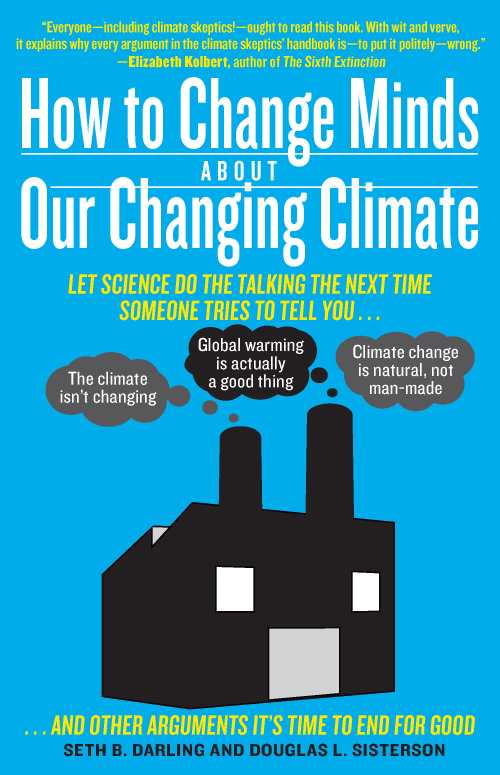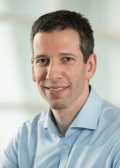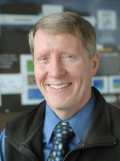Four Tips for Chipping Away at That Climate Change Skeptic in Your Life
Editor’s Note: This commentary by Seth B. Darling and Douglas L. Sisterson, authors of How to Change Minds About Our Changing Climate is part of our ongoing #IndieVoices series of commentaries and features in the month of March focusing on Climate Change. Read the introduction to the series here.
We’ve all been there. Sitting at the kitchen table across from an ornery uncle or scrolling through your social media feed and stumbling on a post from that guy—the climate change skeptic. Come on, dude, really? Deep breath. Unfriending isn’t really an option with Uncle Frank, and while self-selecting our social networks to be ideologically homogeneous may lower our blood pressure, it probably isn’t the best thing for our increasingly polarized society.


So how can you engage with the skeptic, not with heated conflict, but with a sliver of a chance of moving the needle toward common ground based on sound science? Research shows that human sources of carbon dioxide emissions are increasing the atmosphere’s ability to trap heat, causing the average temperature of the planet to increase at an alarming rate. Alternative facts will not change the physics. Here are four simple tips for drawing even a stubborn climate change skeptic back into the light:
1. Yes, it’s our fault. All of us.
If he refuses to accept that the planet is warming, well, good luck. The data are rock solid on that one, and easy enough to check out even for a nonscientist. Where things require a bit more understanding is sorting out the causes for that warming, and we have a tendency here to demonize some caricatured, nebulous, industrial evildoers. This sets things up as the left-leaning tree huggers vs. conservative businesspeople.
Tempting as it may be to point the finger at the big coal companies, the truth is that all of our hands are dirty. Humans don’t like to be wrong. So, it can be a really hard sell to accept that we are responsible for something as bad as climate disruption. After all, we didn’t do it on purpose.
Our planet is warming primarily because of carbon dioxide emissions from the burning of fossil fuels. Energy from that coal, oil, and natural gas has been the engine underlying the breathtaking developments of the past century, including unprecedented improvements in quality of life for billions of people. We’ve all benefited from these developments, and not many of us are eager to go vegan or hand over our cars or air conditioners to save the planet. It’s not “their” fault. It’s ours. That means it’s on all of us to fix this mess.
2. You have home and car insurance, right?
We all deal with risk in our lives. The world is an unpredictable place. Sure, it’s not all that likely that your home is going to burn down, but you’ve probably got home insurance. Will you die young? Probably not, but most of us invest in some life insurance. We buckle up every time we drive even though the chance for an accident that day is low.
So is society going to collapse because of disruptions to the climate? Maybe, and maybe not. But some bad stuff is already starting to happen—rising seas, more severe droughts, stronger storms—and even if the scariest projections turn out to be overblown, doesn’t it just make sense to hedge against that risk?
In this case, it isn’t about getting some climate insurance (although the insurance industry certainly is doing that in a big way). Rather, it’s about making some sensible moves to minimize the risk we face. That means reducing emissions through a combination of energy efficiency and alternative energy sources. Racing forward with business-as-usual just isn’t smart. It’s as reckless as driving without a seatbelt.
3. It’s the economy, stupid
A recurring lesson from national elections in the United States is that jobs are just about everything. When folks are gainfully employed, they can hold on to the American dream. When unemployment creeps up and when income inequality worsens, faith in that dream deteriorates. Vested interests in the energy industry have made the argument, to impressive effect, that shifting from fossil fuels to renewable energy sources will result in people losing their jobs. If you happen to be a coal miner, that may indeed be true. Overall, however, this is simply not the case.
The solar and wind industries are creating jobs at a rate more than ten times faster than that of the rest of the US economy. American jobs directly related to sustainable energy represent more than 4.5 million jobs today, and that number is increasing at a rate of a whopping 20 percent. You can’t outsource a solar installer or a wind turbine maintenance job. The vast majority of economists agree that reducing carbon emissions and increasing alternative energy sources will translate to economic growth, not job losses.
4. It’s about our children and grandchildren
Let us quote our book on this one: “We can all agree, whichever church, mosque, temple, or synagogue we attend, or if we don’t attend at all, and whichever party we vote for—that we want our children’s generation to be better off than our own. Every day that we continue business as usual with fossil-fuel emissions, we are putting this future at greater risk. We are in this together. Climate disruption is probably the greatest challenge we’ve faced as a society, and if we don’t start dealing with it aggressively as a society, it will get the best of us. Climate disruption doesn’t care what political party you belong to or even whether you believe that the climate is changing at all. It will hit you if you’re in Beverly Hills or the shantytowns of Karachi. And it’s relentless.”

Seth B. Darling is a scientist in the Center for Nanoscale Materials at Argonne National Laboratory and a fellow at the Institute for Molecular Engineering at the University of Chicago. His research touches on many aspects of molecular science and engineering, with a particular focus on solar energy.

Douglas L. Sisterson is a senior manager at Argonne National Laboratory for the US Department of Energy’s (DOE) Atmospheric Radiation Measurement (ARM) Climate Research Facility. He often lectures on a range of weather and climate topics in educational environments ranging from middle-school classrooms to scientific forums to TED talks.
Seth B. Darling
